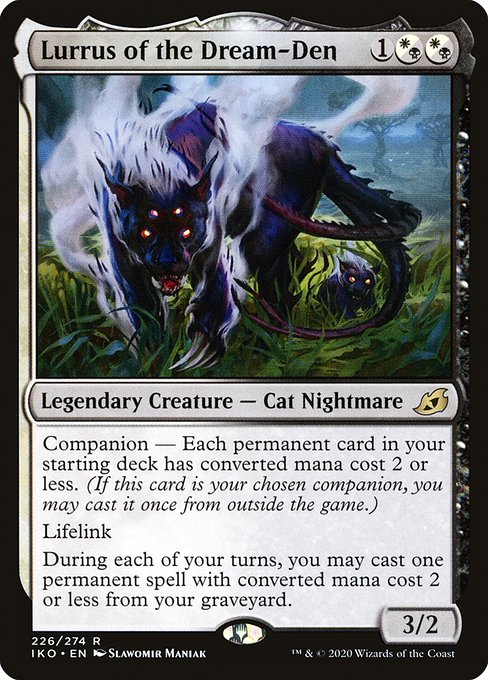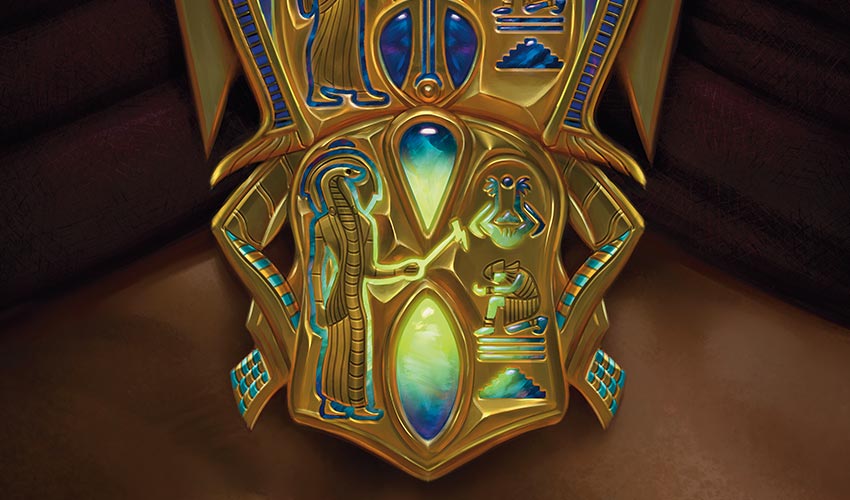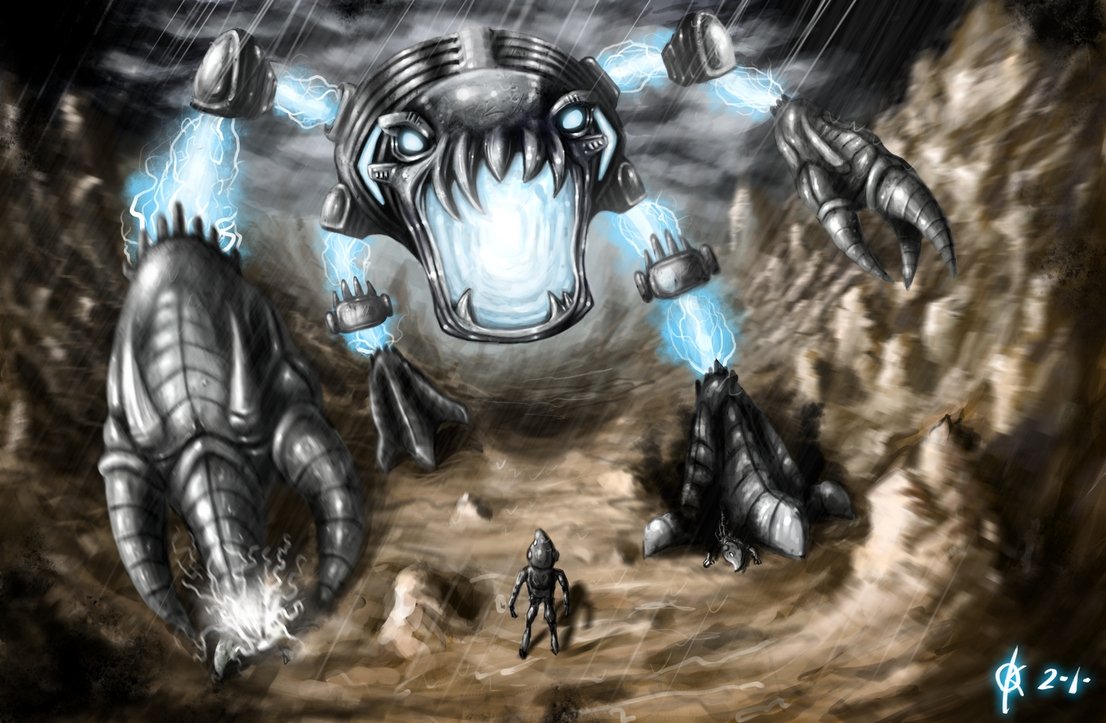Scott takes us through his approach to building budget decks with Companions in Modern and Pioneer with these Budget Lurrus of the Dream-Den decks.
Companions are everywhere. There’s no denying their ubiquity, and for good reason: it’s almost always correct to make changes to your deck in order to start with eight cards in hand. Our main concern as budget players is that when something becomes this prevalent, the demand skyrockets. Card prices follow suit, yet something as powerful as Companions feel like a necessary purchase anyway—at least with Lurrus you only need one copy.

Lurrus of the Dream-Den is arguably the most broken of the companions, and its impact has been immediately felt from Standard back to Vintage. Many of the more expensive decks are being altered to fit this Nightmare Cat—Jund and Grixis Death’s Shadow in Modern, for example—but we can still have our fun with some more affordable builds too.
Lurrus can be pushed in many diirections. You can re-buy creatures killed in the early turns of the game to blunt opposing removal. You can recur enchantment-based removal like Dead Weight. You can loop cards like Soul-Guide Lantern, Abundant Growth, or Mishra’s Bauble to repeatedly gain incremental advantage, making it nearly impossible for “uncompanioned” opponents to keep up.
Let’s look at two flavors of budget deck today: Mono-White Heroic for Pioneer, and Affinity for Modern. These have been designed to showcase the power and flexibility of Lurrus while getting the best value for your hard-earned cash. Each deck can hold its own in their respective formats, and it would appear that no cards will be banned in Pioneer or Modern next week.
Budget Lurrus: Pioneer
Mono White Heroic—14 Tix
| Creatures (15) 4 Favored Hoplite 4 Lagonna-Band Trailblazer 4 Akroan Skyguard 3 Phalanx Leader Spells (27) 4 Cartouche of Solidarity 4 Defiant Strike 4 Ethereal Armor 4 Gods Willing 4 Gryff's Boon 2 Sentinel's Eyes 1 Soul-Guide Lantern 4 All That Glitters | Lands (18) 1 Castle Ardenvale 17 Plains Sideboard (15) 1 Lurrus of the Dream-Den 3 Tormod's Crypt 2 Ajani's Presence 2 Fragmentize 2 Apostle of Purifying Light 2 Baffling End 3 Damping Sphere |
Clocking in at 14 Tix online or $49 in paper, here we have my take on a fast, linear Heroic deck. Popular in Pauper due to its low cost and relatively high power level, the playstyle lies somewhere between Bogles and Orzhov Auras. It’s a deck that saw light play around Pioneer’s inception, and now is a great time to revisit the archetype. The deck can race combo and has a decent Burn matchup, making it a fantastic budget option for the format right now.
Our creature suite is pretty straightforward, as they all do roughly the same thing: gain +1/+1 counters to quickly become terrifying threats. Lagonna-Band Trailblazer’s high toughness makes it a fantastic blocker, Favored Hoplite can easily invalidate damage-based removal and cause blowouts in combat, Akroan Skyguard can fly over and punch through a board stall, and Phalanx Leader can provide a permanent boost to your entire team. The redundancy in your threat suite is a huge boon, which can offset mono-white’s well known lack of card selection.
We have an enchantment package here too, though this one is much more aggressively focused. Sentinel’s Eyes and Gryff’s Boon gives the deck a distinct Build-Your-Own-Serra Angel feel, and Cartouche of Solidarity allows you to pump an attacker while producing a token for defense. Rounding out the auras are a playset each of Ethereal Armor and All That Glitters. Having eight copies of such an impactful card is a great thing, especially as they’re our best way to close out a game.
The remaining cards are Gods Willing and Defiant Strike. Gods Willing pulls double duty—it protects our key threat from removal, but can also be used to help a creature push through blockers. Divine Strike isn’t a powerful card by itself, but when used on our creatures it becomes a one-mana cantripping pump spell, which is a great deal.

The power of Lurrus of the Dream-Den in this deck lies in the ability to replay any removed creatures, mitigating the deck’s main weakness. Usually decks like this tend to flounder once their main threat dies. Now you can replay them and any auras you’ve lost, unlocking a late game that was previously unthinkable. To combat opposing Lurrus decks, there’s a single Soul-Guide Lantern in the main deck, allowing you to exile their graveyard.
Overall, Mono-White Heroic is a great entry into Pioneer and a solid starting point that can be developed in different ways. You can upgrade to the Orzhov version over time if you like a bit more of a grind, or you can add green for Bogles. Either option is viable, fun, and a pretty reasonable call at the moment.
Budget Lurrus: Modern
Lurrus Affinity—29 Tix
| Creatures (23) 3 Memnite 4 Ornithopter 4 Bomat Courier 4 Gingerbrute 4 Signal Pest 4 Vault Skirge Spells (18) 4 Springleaf Drum 4 All That Glitters 4 Cranial Plating 4 Galvanic Blast 1 Seal of Fire 1 Welding Jar | Lands (19) 4 Battlefield Forge 4 Spire of Industry 3 Blinkmoth Nexus 4 Darksteel Citadel 2 Glimmervoid 1 Mountain 1 Plains Sideboard (15) 1 Lurrus of the Dream-Den 3 Tormod's Crypt 1 Welding Jar 2 Deafening Silence 2 Dispatch 2 Torpor Orb 2 Whipflare 2 Wear // Tear |
We haven’t seen a viable Affinity list since the banning of Mox Opal a few months ago, but I believe Lurrus has the ability to shake up the archetype in new and exciting ways with this 29 Tix/$98 build.
Affinity was once a pillar of the Modern format, known for its explosive starts and surprise Infect kills with Inkmoth Nexus and Arcbound Ravager. It may have lost some of its speed, but it’s still capable of quick wins. You didn’t need Mox Opal to win every game, but now with Lurrus of the Dream-Den you can actually survive a few removal spells and generate some extra value.
Memnite and Ornithopter are the quintessential turn one Affinity creatures. Coming down for free and allowing you to turn on Springleaf Drum immediately, and they increase your artifact count. Bomat Courier and Gingerbrute are our hasty attackers, and are great to sacrifice and rebuy with Lurrus, providing us with additional value. Signal Pest is our pseudo-lord effect, pumping all of our attackers while also being evasive. The last of our creatures is Vault Skirge, which is instrumental in gaining life against more aggressive decks like Burn and Prowess.

As I mentioned earlier, Arcbound Ravager and Inkmoth Nexus work wonders together, and have led to many quick wins. We’re not looking to be as explosive as the older versions of Affinity, so we’re forgoing this package in favor of cards that will make us capable of going the distance through disruption and removal, which seems to be Modern’s new modus operandi. You can add them to the deck if you already have copies, though it’s less effective right now and Inkmoths especially are outside the budget.
The real power of this deck comes from our artifact payoffs. Galvanic Blast is a supercharged Lightning Bolt for us, either giving us some fantastic reach to close out a game, or some efficient removal for problematic creatures. Cranial Plating has been a staple of Affinity for years, but now we have All That Glitters to add some redundancy. As an aura it’s a higher risk play that can’t be moved around like Plating, but it’s a closer comparison now thanks to Lurrus recursion.
We have a minimal Lurrus package in the main deck, but it really does pull its weight. Welding Jar can be sacrificed and replayed to completely invalidate most removal in the format, and Seal of Fire gives us a lot of reach to eke out those final points of damage. Besides, most of our creatures are fragile and likely to die. Lurrus adds resilience and helps finish off games that last longer than a few turns.
This is certainly a deck that’s out of left field, but I think that’s one of its strengths. It’s not on anybody’s radar and artifact hate isn’t particularly prevalent. Another strength is the cost; as we don’t have to shell out for Mox Opal, Arcbound Ravager, or Inkmoth Nexus, this won’t empty your wallet anywhere near as quickly as the average Affinity player empties their hand. The entire seventy-five costs under a hundred dollars in paper, and just twenty-nine Tix on Magic Online, which is a steel!
When it comes to upgrades, Lurrus Affinity could be taken and built upon in a number of different ways. The most obvious is to add the aforementioned Arcbound Ravager and Inkmoth Nexus, taking it closer to more traditional Affinity builds. There’s a depth of synergy between Lurrus and Ravager that’s yet to be fully explored, and if you’re playing on Magic Online they’re only an extra 3 Tix for a playset! Inkmoth Nexus are more pricey at 4 Tix/$13 each, but the “win out of nowhere” combo between them and Ravager will significantly increase the deck’s potency. If you like brewing and tinkering with builds, this may be the project for you!
In Closing
These decks are just a quick glance into the capability of the companions and the diversity that they’ve been promoting. While I believe that their fundamental rule-bending nature will end up being a net negative for the health of almost every format they’re legal in, it’s not all doom and gloom. I’m taking solace in the fact that they’ve not only helped reignite people’s fire for brewing, but they’re also helping to revive and rehash long-forgotten archetypes.
I for one welcome our new companion overlords, at least while it’s still fun.
Scott is an Irish content creator and head of the budget division of the Izzet League. His primary focuses are Pioneer, Modern, and Pauper, and he can be found storming off on Twitch and Youtube.

